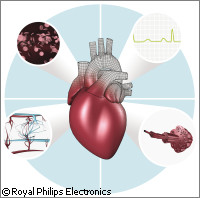EU funds heart project
The EU's Seventh Framework Programme (FP7) has awarded EUR 14 million to a 4-year project, euHeart, for the improvement of the diagnosis, therapy and treatment of cardiovascular disease (CVD). The consortium comprises public and private partners from 16 research, academic, industrial and medical organisations from 6 European countries. In the EU alone, CVD takes the lives of 1.9 million people annually and costs an estimated EUR 105 billion in healthcare. Advances in the management of coronary heart disease and chronic heart failure are, therefore, seen as crucial to reducing the human cost and financial burden of CVD. The euHeart consortium focuses on developing technologies for the diagnosis and treatment of heart conditions such as heart failure, coronary artery disease, heart rhythm disorders and congenital heart defects. Specifically, it aims to develop computer models of the heart on multiple scales, from the molecular level to that of the whole organ, that can be adapted to individual patients. The computer models will be functional as well as structural, incorporating clinical knowledge of how CVD affects the heart at each level. It is hoped that this will lead to the development of tools designed to predict outcomes for different therapies or treatments; if models can be personalised to individual patients, therapy and treatment could be equally personalised. A person suffering from CVD could benefit from having a personalised computer model of their heart because it would address their own peculiarities. For example, the electrical activity in every patient's heart is subtly different; for certain conditions a computerised model reflecting the patient's unique heart structure and function would enable doctors to test the results of destroying different areas of tissue before they have to operate. Multi-scale models have been used mainly in basic research, as the difficulty of adapting these models to individual human beings makes clinical applications impractical. To overcome this problem, the euHeart project intends to develop its models using novel information and communication technologies together with existing clinical data such as computed tomography (CT), magnetic resonance imaging (MRI) and ultrasound scans, as well as measurements of blood flow and blood pressure in the coronary arteries and electrocardiograms. Gene defects in individual patients could also be taken into account. Pre-diagnosed conditions such as heart arrhythmias would likely be the first to benefit from advances in computer modelling of CVD. Heart failure, coronary artery disease and diseases of the heart valves and aorta would also be major clinical focus areas. As in many fields of research, one of the challenges of CVD modelling is integrating the vast amount of emerging and existing data; establishing CVD models on multiple levels could provide a consistent framework for such integration. The euHeart project will establish an open-source framework (using standardised mark-up languages such as CellML and FieldML) for both normal and pathological models that will integrate and interconnect existing and future models from myriad areas of biological research. It will additionally establish a shared library of innovative tools for biophysical simulations, model personalisation and automated image analysis. Creating the highly personalised tools proposed by the consortium is no small feat: the euHeart consortium brings together an incredible amount of expertise and talent from across the EU to make this mammoth task possible. Different parts of the program are co-ordinated by Philips Research, King's College London and the University of Oxford; the consortium also includes participants in Germany, Spain, France and Belgium. The project is part of the Virtual Physiological Human (VPH) initiative, which aims to produce a unified computer model of the entire human body as a single complex system.



